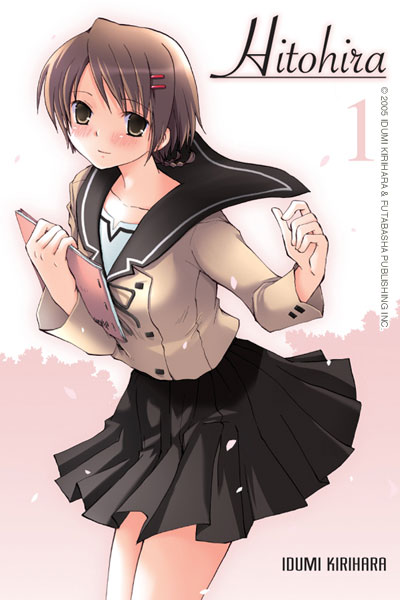 Hitohira, vol. 1
Hitohira, vol. 1
By Idumi Kirihara
Rated T, 13+
Aurora, $10.95
“Some things just aren’t meant to be,” a character exclaims toward the end of Hitohira. “They say that if you work hard, you can do anything. Well, that’s complete bull!”
“Sssh!” responds another character. “You’re contradicting the message of this whole manga!”
Indeed, the story of Hitohira is the story of an apparently pointless struggle against incredible odds. Mugi, the main character, is so shy that she loses her voice whenever she is embarrassed or tense. So naturally, she joins the drama club. It’s either disastrous or brilliant! Since this is manga, we can expect some of each.
The story relies on that hoary manga cliché, the dueling high school clubs. In this case, Kumataka Art Academy has two theater clubs, but only one will survive. There’s the regular Theater Group, which is officially sanctioned, and the splinter Theater Research Group, which has only three members when the story opens: Takashi, Risaki, and their leader, Nono. The assertive Risaki dragoons her kid brother Kai into joining, but they must recruit one more member in order to exist at all. When they hear Mugi belt out her delight at passing the entrance exam… well, a plot is born. Nono asks Mugi to join the club, and Mugi has a panic attack and signs the paper just to get everyone to go away.
The stories and complications that follow will seem familiar to anyone who has lived through high school or read a shoujo manga. Fears are overcome, girls from rival groups become friends, former friends become bitter enemies, etc. There is a schoolgirl crush (on another girl) and a possibly debilitating but certainly not fatal disease. By the end of the volume, the characters have begun to take on definite personalities and the story has been set up. There is just one story that is a disappointing: Nono bets the club’s funding that the members will all score in the top fifty on their exams, but when the results come out, Risaki simply runs off with them and the story is never really resolved. Aside from that episode, Hitohira is a solid high school story that brings the reader into a circle of likeable, if somewhat bland, characters.
Unfortunately, the art is rather weak. Kirihara relies too much on barely modulated tones, which makes the drawings look flat and cartoony. The figures are shaky, particularly in the first part of the book; although the poses are ambitious and lively, the anatomy doesn’t always quite hang together. This does get better as the book goes on, however. What doesn’t improve is the difficulty of telling who is who and who is speaking; Kirihara’s character designs are too similar and her word balloons don’t always point at the speaker. There are also a few obvious bloopers, where a piece of the background is visible through a figure—appropriate in a ghost story, but not here.
In terms of production values, Hitohira is very basic. The print quality of the cover and the interior are pretty good, and the paper is decent, too—which is just as well, because rough newsprint would kill all that toning. There are no color pages or translator’s notes. The book does wind up with a series of 4-koma comic strips about the characters, which is a nice little coda but possibly not enough to justify the extra dollar. In fact, at under 200 pages, the book feels a bit thin.
Hitohira is a decent shoujo title that entertains without demanding too much of the reader. The story is well told, and Kirihara does a nice job of drawing the reader into high-school life. It may not be great literature, but it is a fine way to kill an hour or two.
(This review is based on a complimentary copy provided by the publisher.)
Though I’d like to point out that technically it’s a Seinen title that ran in Comic High (Along with Kodomo no Jikan and “Lolita Complex Saga” and eroge adaptions.)
Though I believe Comic High is the magazine with the slogan, “Girl’s comic for men,” or something like that.
(Mugi is super moe!)
Wow, that moe bit just went right by me. But now that you mention it, I can kind of see it.